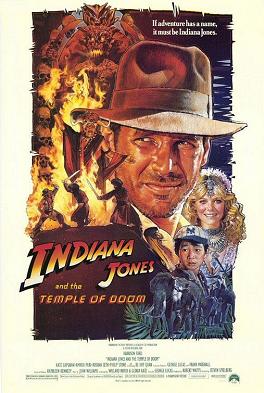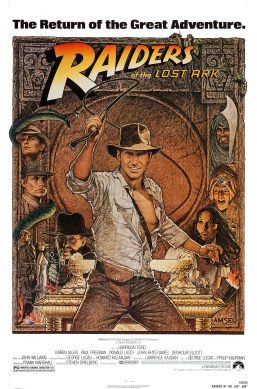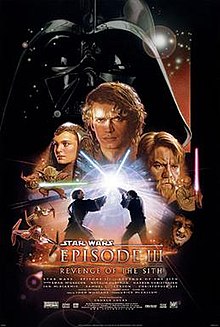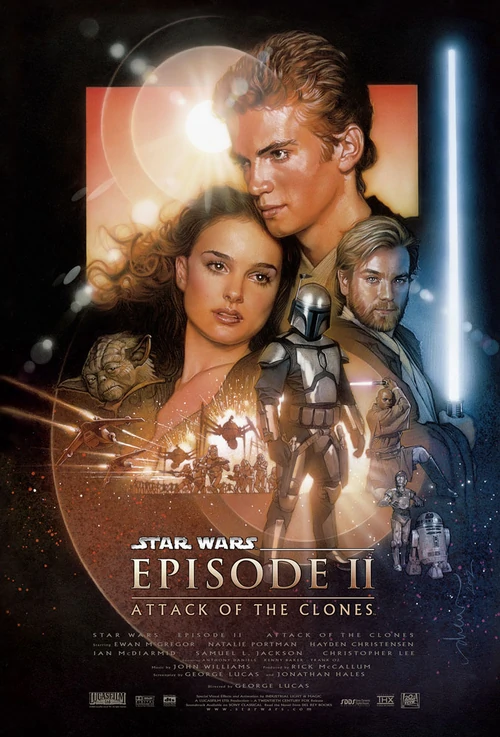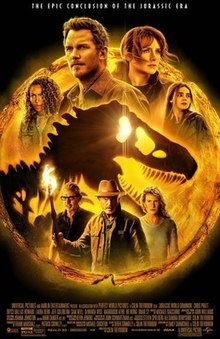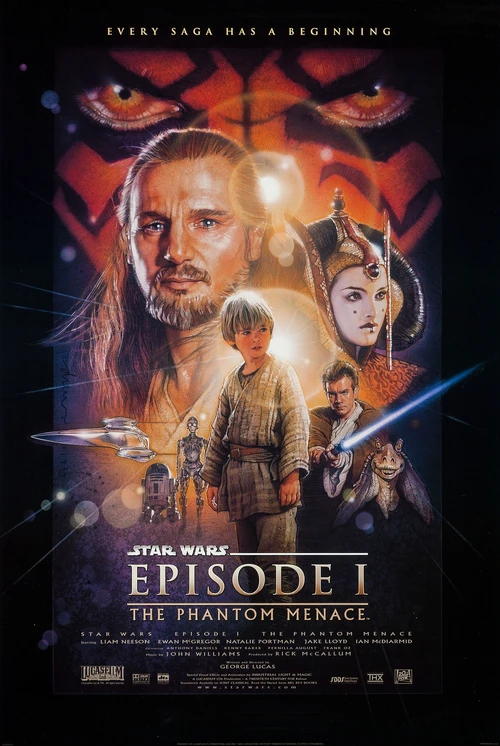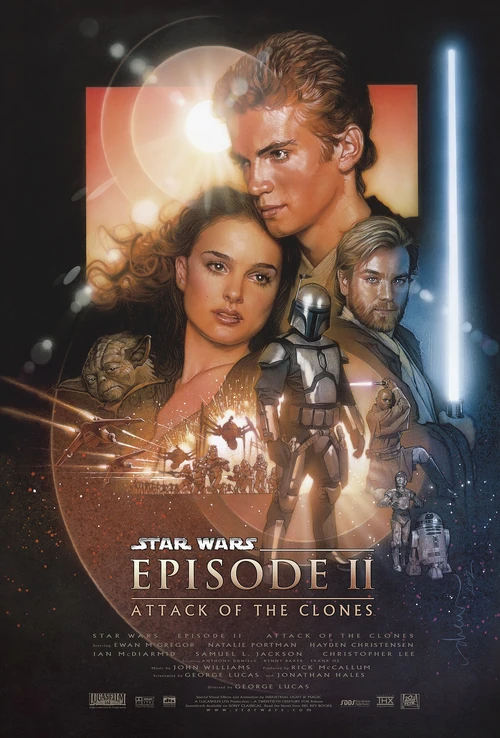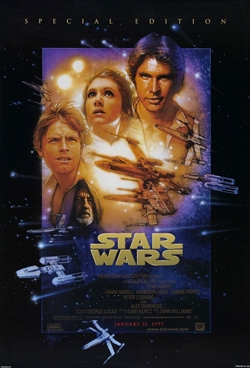 George Lucas originally wanted to make a Flash Gordon film, but couldn’t secure the rights, so he made his own science-fiction franchise instead, which was successful, even if the production of the original film in the series, ultimately subtitled A New Hope and numbered Episode IV of the later-named Skywalker Saga, was troubled. The film itself begins with an opening text crawl through space preceding main entries of the saga, describing the Rebel Alliance’s acquisition of plans to the intergalactic weapon of mass destruction, the Death Star (with spinoff film Rogue One showing this key event in the series chronology).
George Lucas originally wanted to make a Flash Gordon film, but couldn’t secure the rights, so he made his own science-fiction franchise instead, which was successful, even if the production of the original film in the series, ultimately subtitled A New Hope and numbered Episode IV of the later-named Skywalker Saga, was troubled. The film itself begins with an opening text crawl through space preceding main entries of the saga, describing the Rebel Alliance’s acquisition of plans to the intergalactic weapon of mass destruction, the Death Star (with spinoff film Rogue One showing this key event in the series chronology).
One of the Galactic Empire’s star destroyers pursues the vessel of Alderaan’s Princess Leia Organa, who is consequentially captured by Sith Lord Darth Vader in his iconic black life-support armor, although droids C-3P0 and R2-D2, the latter to whom she gave the Death Star schematics, escape, their pod spared destruction by the Imperial forces on account that there were no lifeforms on it, an oversight whose aversion would have ended the events of the original trilogy, and which the Family Guy parody “Blue Harvest” brilliantly points out: “Hold your fire? What, are we paying by the laser now?”
Threepio and Artoo’s escape pod lands on the desert planet Tatooine, an homage to the eponymous world of the Dune literary franchise from which Star Wars would filch other narrative elements, and they briefly separate before reuniting, thanks to the diminutive scavenging Jawas, at the moisture farm of Owen and Beru Lars, to whom they sell the droids and with whom their stepnephew Luke Skywalker has been living since his infancy, unaware of his lineage and power, given his stepaunt and stepuncle’s keeping him in the dark about his biological family.
Luke discovers the message Leia left for hiding Jedi Knight Obi-Wan Kenobi, who served her father in the Clone Wars, when tinkering with Artoo, who defies his new owners and makes for the Jedi’s residence, Luke following and rescued from the sand people by his old friend Ben Kenobi. The “twist” that Obi-Wan and Ben are one and the same is somewhat asinine, with how the aging Jedi adopted an alias that included his real last name questionable (although as his Disney+ series demonstrated, he didn’t get off scot-free), and personally, I think that just “Ben” as an alias would have done just fine and accounted for a better revelation.
Obi-Wan, when he brings Luke to his home, reveals more of the franchise’s critical backstory, mentioning that the Jedi had served the Galactic Republic “for a thousand generations,” which Episode II would contradict with then-Supreme Chancellor Sheev Palpatine stating that the Republic had stood “for a thousand years” (which the now-Legends material would semi-resolve). He continues by indicating that his rogue pupil Darth Vader would betray and lead a genocide against the Jedi Order, with the Dark Times approaching and Galactic Empire subsequently rising. Kenobi also mentions the mystical energy source known as the Force, and gives Luke a keepsake of his father, his blue-bladed lightsaber.
The duo visits Mos Eisley in hopes of finding a pilot to take them to Alderaan, finding Han Solo in a bar, before which two aliens for unknown reasons pick a fight with Luke, with Obi-Wan coming to the rescue though revealing his lightsaber in a lapse of judgement. Han boasts that his vessel, the Millennium Falcon, “made the Kessel Run in less than twelve parsecs,” with many, such as the mentioned Family Guy spoof, noting that a parsec is a measure of distance, not time (and the prequels would use the unit correctly). Though Solo’s spinoff film would shed light on this, I personally think Han was an idiot just BSing about his ship’s capabilities.
Han also has dealings with the minions of crime lord Jabba the Hutt, including Greedo, who confronts the human pilot one-on-one and threatens to take his life. I honestly don’t care who got the first shot, originally Han, then Greedo in the 1997 rerelease, and then both shooting simultaneously in the latest version of the film. Being a writer myself (though I’ve rarely written fiction in the past few years), I occasionally like to change certain details to my works, so I can somewhat emphasize with George Lucas. The 1997 rerelease adds a scene where Solo interacts with Jabba, with a cameo by bounty hunter Boba Fett, that gives some foreshadowing.
In the meantime, the Imperials interrogate Leia as to the location of the Rebel base, the Death Star parked above her homeworld Alderaan, which they threaten to destroy if she doesn’t say. They blow up the planet anyway when she gives a false answer, and while it’s sad what happens to the planet’s people, they are somewhat unintentionally unsympathetic, since Leia made no effort before her capture to warn its inhabitants that the world might be a target for the Empire, and they make no noticeable effort to evacuate (and the planet didn’t even have a moon, so the space station was in plain sight). Were the station completely facing the dark side of the planet, I could understand how the destruction would have taken them by surprise.
Back on Tatooine, Luke, Ben, Han, and his furry friend Chewbacca fight Imperials to escape the planet along with Threepio and Artoo, going into hyperdrive to Alderaan and arriving too late to the destroyed world. The Millennium Falcon is tractor-beamed into the nearby Death Star, where its passengers elude capture, Luke and Han stealing stormtrooper armor and pretending Chewy is a prisoner, going to the detention block to free the captive Princess Leia. The Imperials ultimately catch on to the rescuers, and they escape through a garbage chute. Kenobi, before this, separates from the rest of the party, and confronts his old apprentice Darth Vader.
Most of the heroes escape, but not without the Millennium Falcon having to face off against several TIE fighters, after which Princess Leia rightfully suspects that the Imperials put a tracking device on the vessel, and given that the others aboard didn’t have the sense to change transportation or try to get rid of the tracker, she could have at least warned the Rebels on the moon of Yavin where their base was that the Death Star was on its way. Han’s ship reaches the base, and he leaves Luke, Leia, Threepio, and Artoo there while going off on other business, having helped the others simply for money involved.
The Rebels find through the stolen plans that the battle station has a weakness in an exhaust shaft leading directly to the core, where carefully aimed ammunition can set off an explosive chain reaction to destroy the mobile Imperial base. The Death Star does ultimately arrive in the system where the Rebel base is, although instead of simply blowing up the gas planet the moon was orbiting, which would likely have some sort of effect on the gravity, atmosphere or whatnot of Yavin IV (unless the planet it revolved around didn’t have a solid core), they decide to wait and circle the world to crush their enemies directly.
The battle which follows is awesome and flashy, even more so in the remasters, with inspiration from war films that predate A New Hope, although both sides of the war constantly forget that outer space isn’t two-dimensional, and one could easily wonder why the Rebels couldn’t simply fly directly towards the exhaust shaft instead of having to skim the trench before it. It’s also somewhat baffling that in the face of destruction by the Death Star, that the Rebels don’t evacuate their lunar base; were they confident they were going to win the battle?
Luke does succeed in blowing up the Death Star, although the logic in how this happens is somewhat flawed, as the torpedoes are shown moving straightforward a great distance before curving into the shaft. The Rebels win, several high-ranking Imperials deceased as a result of the Death Star’s destruction (but Darth Vader does get away), and the insurgents hold a victory ceremony on Yavin’s moon, ending the film. Naturally, the film’s phenomenal success would convince George Lucas to turn it into a franchise (though as holes that would consequentially emerge in the series would demonstrate, he wasn’t completely foresightful), an endeavor that continues to profit today, and I’m certain our descendants will be watching new Star Wars films and television series (not to mention reading many spinoff books) in the indefinite future.
John William’s score for the film and its brethren is notable, the theme played during the opening crawls of the Skywalker Saga movies having a motif like Paul Dukas’ “The Sorcerer’s Apprentice,” and a refrain like Tchaikovsky’s “Marche Slave.” Most of the soundtrack takes inspiration from Gustav Holst’s The Planets suite, mostly the Mars movement, other classical musical pieces such as “The Rite of Spring” influencing the score as well. The film ends, like its chronological and temporal successors and predecessors, with a remix of the opening crawl theme that led me to watch the closing credits to the end just to listen.
All in all, A New Hope is certainly an amazing film—there’s absolutely no question about that—but has serious flaws that need consideration before passing it off as an infallible masterpiece, such as its countless plot holes and questionable narrative choices that would plague other entries of the space opera franchise. It does also show its age in some respects, but doesn’t scream “the 1970s,” especially with the “controversial” aesthetic touchups effected since the original release, and while I think movies should be judged on their actual content and cohesion than influence and importance, positive or negative, it’s very much a bucket-list film, and a high point of cinematic science-fiction, even if it did show George Lucas’s inexperience as a screenwriter, which would of course continue into the following decades.




